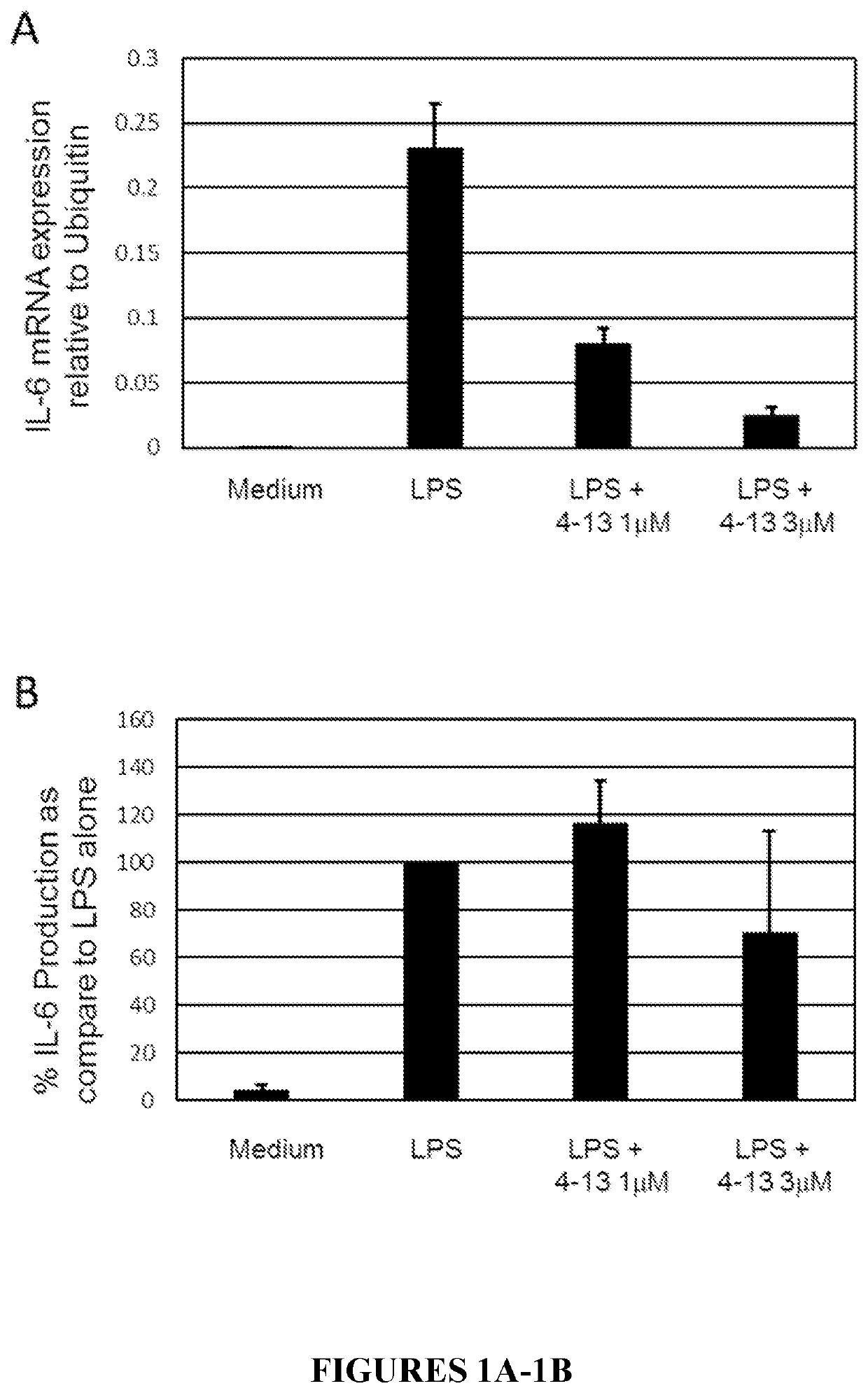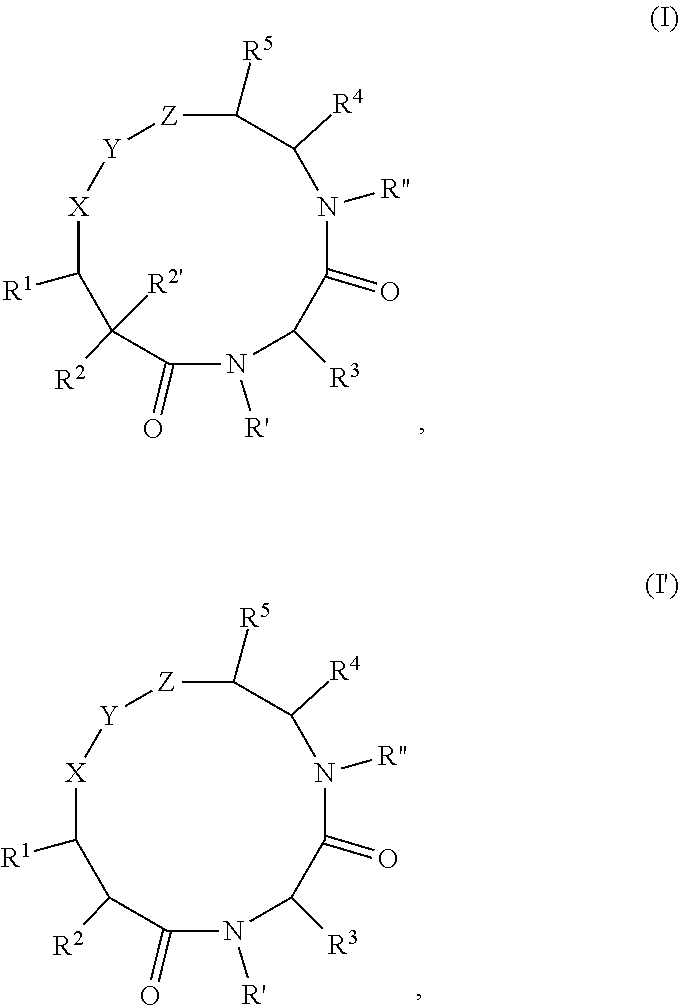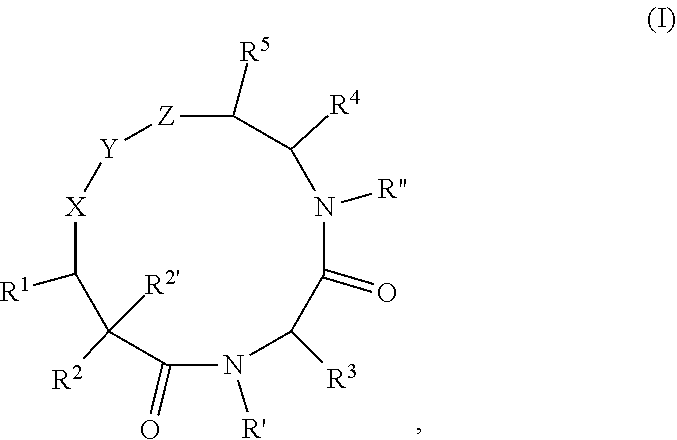Macrocyclic compounds as proteasome inhibitors
- Summary
- Abstract
- Description
- Claims
- Application Information
AI Technical Summary
Benefits of technology
Problems solved by technology
Method used
Image
Examples
example 1
of (5S,8S,11S)—N-((1-Methyl-1H-pyrazol-4-yl)methyl)-7,10-dioxo-8-phenethyl-11-(piperidin-1-yl)-2-oxa-6,9-diaza-1,3(1,3)-dibenzenacyclododecaphane-5-carboxamide (1-01)
[0243]
[0244]To a mixture of 1-68-1 (10 mg, 0.017 mmol) and NMP (0.4 mlL) (1-methyl-1H-pyrazol-4-yl)methanamine (0.017 mmol) was added followed by HATU (0.020 mmol) and TEA (0.020 mmol). The mixture was stirred at room temperature for 30 minutes and a 4M solution of HCl in dioxane (0.255 mL, 1.021 mmol) was added. The mixture was heated to 80° C. for 3 hours then cooled to room temperature and passed through a solid phase extraction column (scx-25 g), washed with MeOH (3*8 mL), and eluted with 2N ammonia MeOH (3*8 mL). Volatile organics were removed by evaporation to provide 1-01-1 which was used immediately without purification.
[0245]To the isolated 1-01-1 NMP (0.4 mL) was added followed by TEA (0.104 mmol). Then 1,5-dichloropentane (0.085 mmol) was added and the mixture was heated to 80° C. for 120 minutes. The reactio...
example 2
of (5S,8S,11S)—N-((1-Methyl-1H-pyrazol-4-yl)methyl)-11-(1-methylpiperidine-4-carboxamido)-7,10-dioxo-8-phenethyl-2-oxa-6,9-diaza-1,3(1,3)-dibenzenacyclododecaphane-5-carboxamide (1-03)
[0258]
[0259]To the isolated 1-01-1 NMP (0.4 mL) was added followed by TEA (0.085 mmol).
[0260]Then the N-methylisonipocotic acid (0.068 mmol) was added followed by HATU (0.068 mmol). The mixture was stirred for 60 minutes and then filtered through cotton wool. The product was purified by reverse phase HPLC to provide 1-03. LCMS of 1-03: RT=6.26 min, m / z 706.36 [M+H]+.
[0261]The following compounds were made using a similar synthetic route as described for compound 1-03:
[0262]Compound 1-05; LCMS: RT=5.43 min, 639.72 m / z [M+H]+
[0263]Compound 1-06; LCMS: RT=7.56 min, 599.28 m / z [M+H]+
[0264]Compound 1-07; LCMS: RT=7.25 min, 597.30 m / z [M+H]+
[0265]Compound 1-11; LCMS: RT=7.30 min, m / z 635.28 [M+H]+
[0266]Compound 1-12; LCMS: RT=8.26 min, m / z 682.29 [M+H]+
[0267]Compound 1-13; LCMS: RT=7.47 min, m / z 685.31 [M+H]...
example 3
of (5S,8S,11S)—N-((1-Methyl-1H-pyrazol-4-yl)methyl)-11-(methylsulfonamido)-7,10-dioxo-8-phenethyl-2-oxa-6,9-diaza-1,3(1,3)-dibenzenacyclododecaphane-5-carboxamide (1-04)
[0290]
[0291]To the isolated 1-01-1 DCM (1 mL) was added followed by TEA (0.85 mmol).
[0292]Then methane sulfonyl chloride (0.068 mmol) was added and the mixture was stirred for 60 minutes. Volatile organics were removed by evaporation and NMP (0.4 mL) was added. The mixture was filtered through cotton wool. The product was purified by reverse phase HPLC to provide 0.0145 g (22.1% yield) of 1-04. LCMS of 1-04: RT=6.18 min, m / z 659.78 [M+H]+
[0293]The following compounds were made using a similar synthetic route as described for compound 1-04:
[0294]Compound 1-08; LCMS: RT=7.19 min, m / z 619.25 [M+H]+
[0295]Compound 1-35; LCMS: RT=6.26 min, m / z 565.20 [M+H]+
[0296]Compound 1-37; LCMS: RT=7.76 min, m / z 621.27 [M+H]+
[0297]Compound 1-38; LCMS: RT=6.23 min, m / z 673.00[M+H]+
PUM
| Property | Measurement | Unit |
|---|---|---|
| Structure | aaaaa | aaaaa |
Abstract
Description
Claims
Application Information
 Login to view more
Login to view more - R&D Engineer
- R&D Manager
- IP Professional
- Industry Leading Data Capabilities
- Powerful AI technology
- Patent DNA Extraction
Browse by: Latest US Patents, China's latest patents, Technical Efficacy Thesaurus, Application Domain, Technology Topic.
© 2024 PatSnap. All rights reserved.Legal|Privacy policy|Modern Slavery Act Transparency Statement|Sitemap



